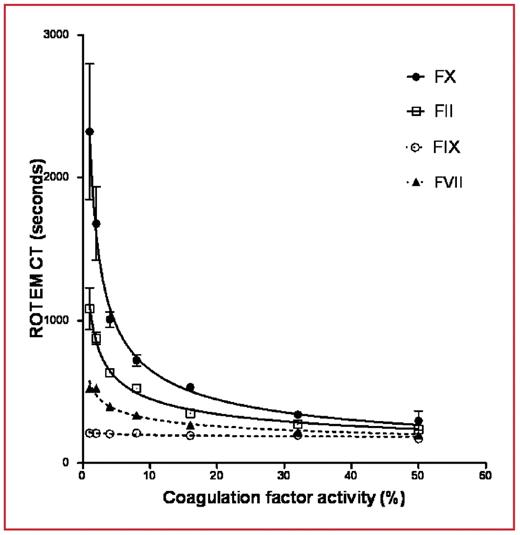Abstract
Prothrombin time based tests used to monitor coumarin anticoagulation measure the initiation phase of fibrin formation (clotting time, CT) in platelet poor plasma. Additional information can be obtained using computerized rotational thromboelastometry (ROTEM) which also measures the consequent propagation phase (measured as maximum velocity, Vmax), and the stabilization phase (maximum clot firmness, MCF).
We used ROTEM to study the effect of individual vitamin K dependent (VK) coagulation factor (F) concentration on clotting induced by dilute thromboplastin in platelet poor and platelet rich plasma (PPP and PRP).
As expected, FII, FVII and FX in PPP equally affected the prothrombin time whereas FIX did not. In PPP the ROTEM CT, however, was affected more by the concentration of FII and FX than by FVII (data not shown). To imitate physiological clotting better, factor deficient platelet poor plasma was repleted by adding frozen platelets in an optimal concentration corresponding to 100 × 109/L.. In the PRP the ROTEM CT was more dependent on the concentration of FII than of FVII, more dependent on FX than on FII and not dependent on FIX at all (left figure). The Vmax (reflecting the propagation phase) was also more dependent on FII and factor X than on the concentration of FVII or FIX which both may demonstrate a threshold effect (right figure). The stabilization phase or maximum clot firmness (MCF, not shown) was influenced similarly by FII and FX but was not influenced by FVII or FIX.
Conclusion: During deficiency of vitamin K dependent coagulation factors the concentration of FII and FX may be more critical for hemostasis than FVII or FIX concentration. This may have practical implications for the appropriate choice of monitoring assays during coumarin administration.
Disclosures: No relevant conflicts of interest to declare.
Author notes
Corresponding author



